#fermented coconut water
Explore tagged Tumblr posts
Text
How To Drink Coconut Water Without Worrying About Its Sugar Content
youtube
Ok, let me tell you so many good things about this idea of fermenting coconut water.
First of all you will get a good amount of beneficial bacteria and yeast that are naturally present in coconut and help the process of consuming all the sugar naturally for you.
Second of all you will have plenty of potassium easily with no spike of insulin
Finally the acidity in this drink is fantastic for your digestion just like apple cider vinegar.
It is super easy to make, just buy a coconut and put it in the freezer. This makes it easy to break and get the juice out without having to pierce the coconut with any metal and introducing any unwanted bacteria.
#fermented coconut water#potassium#high potassium foods#potassium rich foods#how to treat hypokalemia#best food sources of potassium#what foods have high potassium#keto-friendly#diabetic freindly#carnivore diet#paleo diet#what drink is high in potassium#what rasises potassium fast#foods high in potassium#high potassium paleo food#foods rich in potassium#natural sources of potassium#sugar free#low carb#insulin resistant#Youtube
0 notes
Text

Cultured Cherries, Berries & Figs (Vegan)
Eat as is for a yummy snack, add to smoothies, nice-cream, on top of smoothie bowls or blend through coconut yogurt
44 notes
·
View notes
Note
Do you have any healthy snack suggestions for someone who isn't a huge fan of nuts and dried fruit?
FIRST: A 'Snack' is just a small portion of food. It is a signifier of quantity. 'Snack' does not exclude any type or form of food - it just means a lil' bit of food.
SECOND: "Healthy" is entirely relative to every individual.
'Healthy' is just 'Supportive of a complete nutritional profile, taking into account a person's existing diet, dietary needs, and habits of energy expenditure'
For example:
A small, greasy hamburger is an EXCELLENT snack for a highschool athlete who needs to consume an large amount of calories every day to maintain their body. It has lots of fat and protein for muscle recovery and long-term energy, carbs for immediate energy, and some lettuce/tomato/onion for some extra fiber/vitamins/minerals.
On the flip side, if someone already eats a fair amount of of meat and carbs already but has a lower-energy lifestyle, a healthy snack for them might entail leafy greens, beans/legumes and vegetables, because they need more fiber and nutrients in their diet that plants have in abundance.
--
If you are allergic to or hate eating something, then it's not healthy to force yourself to eat it anyway. Find a different food, or a different way to prepare it that doesn't cause physical or psychological distress!
Don't like peanuts, but peanut butter is good? Eat peanut butter instead! Hate the texture of whole tomatoes, but tomato sauce is good? Eat tomato sauce instead!
Don't be afraid to finely mince or blend your ingredients into a sauce or smoothie if you feel you need or want to eat something for the nutrients but hate chewing it.
--
I'm a big fan of probiotic stuff in general, like fermented foods (kimchi, pickles, sauerkraut, miso, mustard and yogurts), since a strong bacterial colony in the gut has a positive impact on wellbeing for most folks. More importantly, I love the taste.
Buuuuuuuut~ some people are extra sensitive to compounds that are concentrated in fermented foods. Those people should not eat a lot of fermented foods. It's not healthy for them.
--
If you're munching snacks out of boredom when you're not actually hungry, something low-fat but satisfyingly crunchy usually does the trick for me. Something I can keep devouring for the sensory delight, gives some good nutrients, and won't make me feel overly full afterward.
Carrots, bell peppers, mung bean sprouts, apples, pears, jicama, radish, pretzels, sweet onions, green papaya, broccoli, popcorn, cucumber, water chestnut, seaweed crisps, coconut chips, any of those fermented foods I mentioned... hell, coleslaw is mostly cabbage with oil and vinegar - plow through that and have a great time!
--
If you want a snack because you're hungry, but you just want to tide yourself over until the next meal, eat something that is high in fat and fiber. Fat & Fiber makes you feel full.
Cheese, Yogurt, Butter. Olive oil. Guacamole. Tinned fish. Cream. Fry up an egg. Olives, Hard-boiled eggs - These are all relatively high in fat.
Beans, Legumes, Oats, Leafy Greens, and most Berries are pretty high in fiber, and can pair up with any of the fatty things.
Hell, a slice of cheese pizza is also fine! Buttered toast is fine! A small portion of roast beef from last night's dinner!
Eat a little bit, wait 20 minutes, and see if you're still hungry after that. A normal stomach takes 20-30 minutes to register feeling satiated. (Some people's stomachs don't really feel the difference of hunger vs satiation. Those people need to be more mindful of the quantities of food they eat - both eating too much, AND eating too little!)
--
If you want a snack because salty snacks in particular sound fucking amazing, but other fatty and high-protein foods sound kinda gross, Try chugging a glass of water.
If water doesn't resolve the feeling after giving it a few minutes, try something with salt.
Dehydration and not having enough salt in your body both cause salt cravings. Acute thirst is often mistaken as hunger.
Honestly, you can have a handful of chips. Eating a whole family-sized bag of potato chips in one sitting is probably too much salt & fat for most people, but eating a handful here and there is fine. It's just as morally neutral as eating a carrot.
Eat some rice with soy sauce. Eat some pickled okra, or pickled onions. Eat some miso soup. Drink some soup broth. Have some salt-cured meats.
--
So: A Healthy Snack!
Ask yourself: Am I hungry, bored, or thirsty?
Ask yourself: What have I been eating lately, and what has my diet lacked, or had in excess? (Fats, Protein, Carbohydrates, Vitamins/Minerals, Water, Salt)
Ask yourself: Am I trying to provide my body with a complete nutritional profile, including fats and carbs - or am I focusing on an imagined 'purity' of food and assigning moral value to eating what diet culture calls healthy so I can be 'good.' (Aka: Do you think instances of eating candy or fatty food is 'being bad'? Stop that.)
Ask yourself: Am I able to rely on my body's signals for hunger and thirst, or do I need to manually track this?
Sometimes a snack is a small portion of leftovers from yesterday.
Sometimes a snack is carefully sliced, cooked, and arranged on a cute plate.
Sometimes a snack is gnawing through half a head of cabbage doused in vinegar.
Sometimes a snack is a handful of shredded cheese eaten from your own palm so you become both the gentle horse and the stablehand feeding it, and that's all okay
#fuckingrecipes#kitchen tips#food#relationship with food#healthy food#snack#snacks#snack ideas#healthy snack#I want chipotle#I SAID A HEALTHY SNACK REBECCA
721 notes
·
View notes
Text
Gut Friendly Grocery List 🥦🥑🧀
🧀 Probiotic and Fermented Foods:
Yogurt (look for live and active cultures)
Kefir
Sauerkraut
Kimchi
Pickles (fermented)
Tempeh
Miso
Fermented cheeses (e.g., cheddar, gouda, Swiss)
Kombucha
🫘 Fiber-Rich Foods:
Whole grain bread, cereal or pasta
Oats
Brown rice
Quinoa
Lentils
Chickpeas
Black beans
🍳 Protein:
Lean meats (chicken, turkey, lean cuts of beef or pork)
Fish (salmon, mackerel, sardines)
Eggs (rich in amino acids)
Tofu and tempeh (fermented soy products)
Cottage cheese
🍎 Fruits:
Berries (blueberries, strawberries, raspberries)
Bananas
Apples
Oranges
Lemons
Watermelon
🥦 Vegetables:
Spinach
Broccoli
Cauliflower
Brussels sprouts
Asparagus
Onions
Garlic
Artichokes
Sweet Potato
Jicama
Chicory root
Dandelion greens
🥜 Nuts and Seeds:
Almonds
Walnuts
Flaxseeds
Chia seeds
Pumkin seeds
🥑 Healthy Fats:
Avocado
Olive oil
Grass fed butter
🍠 Herbs and Spices:
Turmeric
Ginger
Garlic
🧉 Beverages:
Green tea
Herbal teas
Aloe vera juice
Coconut water
🍫 Other:
Dark chocolate (in moderation)
Apple cider vinegar
Bone Broth
Raw honey
sea salt
Collagen
Seaweed
#gut health#healthy diet#healthy living#health and wellness#health#wellness#healthy lifestyle#health is wealth#groceries#nutrition
3K notes
·
View notes
Text


[ID: A thick white stew topped with a symmetrical pattern of fried garlic, minced parsley, and 'meat' chunks in a bright blue bowl. End ID]
كرناسة / Karnasa (Palestinian yoghurt and rice stew)
Karnāsa, or لَبَنِيَّة ("labaniyya") is a Palestinian dish of short-grain rice cooked in لبن ("laban") and topped with a tadka of fried garlic. "لبن" in Palestine refers to لبن زبادي ("laban zabādi,") or thickened sour milk (aka yoghurt). Laban is used to make a variety of sauces that are served with meat dishes, stewed vegetables, and maḥshis (stuffed dishes); it may also be strained and preserved as labna. Past batches of laban are traditionally used as a starter to ferment new batches from fresh milk.
Karnasa may be made plain, or with fried cauliflower or green beans; the latter variation, called لبنية ال��ول ("labaniyya al-fūl," labaniyya with beans) is often eaten during the winter.
It is an older custom to prepare karnasa in the morning, then serve it with meat as a lunch forعِيد اَلْأَضْحَى (Eid al-Adha), the Festival of the Sacrifice. Eid al-Adha celebrates the willingness of إبراهيم (Ibrahim) to sacrifice his son at God's command: the أضحية ("uḍḥiyah"), or sacrifice of livestock, occurs accordingly on the first day of the three-day festivities. Families may purchase livestock—often goats or sheep—and share the meat with neighbours, friends, and extended family.
Karnasa is sometimes served alongside khubbiz tabūn, a fermented flatbread, which is torn and dipped into the stew. In this recipe, the robust sourness of the flatbread melds with the tangy, creamy yoghurt and tender, savory seitan to produce a satisfying meal that's delicious hot or cold.
Donate to an evacuation fundraiser
Donate to Help Gaza Children
Ingredients:
Serves 4.
For the dish:
1kg (4 cups) vegan yoghurt (لبن زبادي)
1 Tbsp cornstarch
190g (1 cup) Egyptian rice, or other short-grained rice
225g (8oz) meat substitute such as seitan chunks; or cauliflower
1 Tbsp kosher salt, or to taste
1 cup vegetable stock, or 'meat' stock from cube or concentrate
1 Tbsp olive oil, for frying
Parsley or dried mint (optional)
For the tempering (ṭsha / طشة):
1/2 head garlic, chopped
3 Tbsp olive oil
For best results, use a thick yoghurt such as soy or coconut, rather than a thinner one such as almond.
To make your own cultured cashew laban, follow my cultured vegan labna recipe, but double the amount of water and skip the pressing in cheesecloth step.
Instructions
1. Rinse your rice once by placing it in a sieve, putting the sieve in a closely fitting bowl, then filling the bowl with water; rub the rice between your fingers to wash, and remove the sieve from the bowl to strain. Fill the bowl with fresh water and submerge the rice to allow to soak for 30 minutes to an hour.
2. Whisk laban and starch together and heat in a thick-bottomed pot on low until simmering, about 10 minutes.
3. Add rice and stock and mix. Cook, stirring often, until the rice is fully cooked and the texture of the stew is a little thinner than what you want (it will thicken as it cools).
4. Meanwhile, heat 1 Tbsp oil in a skillet on medium. Fry meat substitute, stirring occasionally, until browned. Set aside.
5. Make the tsha: In the same skillet, heat another 3 Tbsp olive oil on low. Add garlic and fry, stirring often, until a shade lighter than desired. Remove from heat.
6. Stir in salt and tsha. Ladle into individual serving bowls and top with meat; or, cut meat into small pieces, add into the pot, and simmer another minute or two before serving.
7. Top with parsley or dried mint. Serve hot or cold, with flatbread.
258 notes
·
View notes
Text
My attention is almost always focused on and directed towards what I desire to bring into the 3D reality, whatever brings incredible levels of lubrication, expansion, liberation, discomfort, purpose, or fun, and rarely, if ever, am I focused on what I don't. I live cognitively and somatically in abundance in my thinking and feeling, and generally believe that whatever I desire is possible, no template or carved out path needed. There is not one person on Earth who I have spent significant time around that hasn't heard me moan, sing, yell, and scream. I command life through my Sounds . I decree through my voice. I energize through my deep throat (chakra). A vagus-nerve-tending life, as I call it, is a life of relaxation, deliberate creation, and play, that requires us to normalize using our sounds, to tend to our throats, to ‘will’ life in the direction we really desire through our vocals, and to deeply listen for next step instructions. I was told to connect to the water element to access sacred flow states, surrendering to the current and affirming out loud that the universe had a plan, and all I needed to do was relax at the water, pray and wave at the boats passing by. In other words, I became obedient to the universe, therefore I did not have to become exhausted and worn down because I was trying to force something to happen as learned. Instead, I allowed myself to feel safe being helped and supported by something (mostly) invisible and eternal.
My consciousness has drastically increased since publishing my first book "You Look Like Something Blooming" to crafting a new series of books, "The Melody of Love." Speaking with an upgraded consciousness required me to open up my crown through a purification process of slow deep circular breathing, eating real food mostly prepared by me, and channeling my "life energy" or sexual vitality with my heart in order to be able to receive higher messages and downloads. Through some combination of meditation, breathwork, chanting, sacred bathing, kundalini yoga, female sexual alchemy exercises, eating mostly organic, wild, or fermented foods, and/or spending quiet time alone or in nature, especially in warm sunny regions, permitted my 3rd eye to open therefore I could process the higher intelligence I was receiving without having an inflammatory response. And my throat chakra had to evolve to allow me to communicate the advanced messages I was receiving and processing in the simplest, down-to-earth fashion as possible to readers. But none of that would have been possible if feminine expression had not been grounded into my body over the years through root posterior chain work, calve work, and feet work that gave me strength and softness to be able to hold a greater capacity of energy and allow it to pulse through my body and psyche, you see. When your soul lives in a human body, this is the only true way "ascension" happens, from the bottom up. But I am also very grown AF. Not a day that goes by that I don't connect to my throat (pussy, or breasts) and feel the profound peace of the present moment. Like open my mouth and massage my back teeth and throat with coconut oil which also massages my pelvic floor and reproductive organs because the throat, pussy, and pelvis are all energetically and physically connected. What you do to one is done to all parts. Because one thing I know about women is that we live too closed. Our legs need to be open. Our breasts/hearts need to be open. Our spines need to be open. Our minds need to be open. Our hips need to be open. Our toes need to be open. Our buttocks need to be open. And of course our throats need to be open. It’s like women learn to be talk and talk all the time but we do not learn to open up our throats so that energy can properly flow into our eyes, inner eye, and brain, which means that we can finally ‘see,’ ‘feel’, ‘hear’ and interpret at the subtlest layers of reality again. The lack of real circulation is harming our bodies of their greater capacities. That's why the average woman has not touched the tip of what's possible in her body, life, and intimacies. The chronic negative thoughts have carved calcification imprints in her creative portals, made them hard and full of scar tissue. "The Melody of Love" books and school share how to dearmour the female body and unleash the raw multidimensional creative potential for every female body, the hidden, the regenerative, and the uncommon. I created my soft life (the real kind) because I learned how to live tuned in and tapped on in my body and mind, and I want to teach more women and other female-bodied people everything I know. Because when I do look out into world I see that this world needs us. More embodied women. High Priestesses. -India Ame'ye, Author
Only posted for 48 hours.....
92 notes
·
View notes
Note
Hi! Thank you for the health advice! I would love to quit or significantly reduce carbs, I also feel like it's heavy on my body, but so many meals revolve around grains (sourdough bread mostly) and I guess there's a craving aspect to it too... Could you give advice on what you're eating instead?? I have lots of eggs, fish, occasional meat, plenty of fruit, just enough veg haha but i find it hard to imagine going without carbs (or grains more specifically cos I have no prob with vege carbs). Especially in winter 😋 Thank you for any help 🙏🙏
I feel like society has normalised feeling heavy and lethargic after meals, but its amazing you have noticed this and want to change!
You may want to cut carbs gradually (no starches - breads, grains, rice, pasta, potatoes).
I would recommend looking into GI index to see what foods are high glucose, following Hormone Balancing recipes, juices etc (usually very low carb and support women's health). Listening to podcasts on microbiome, or even a tiktok search.
Introducing pre/ probiotics: I make sauerkraut (which is basically cabbage / onions in water and salt left to ferment for a few days - lots of variations on this), also just made my first batch of Kefir (I stay away from store bought Kefir as its pasturised and all the good stuff has been killed off during this process). I mention these as a healthy gut is going to support you as you remove carbs and introduce more wholesome foods.
Breakfasts:
Omlette (spinach / onion / parsley )
Scrambled eggs w/ coconut oil
Buckwheat porridge w/ blueberries (buckwheat is a seed not a grain so low glucose index)
Avocado salad (seeds, olives, rocket, tomatoes, cucumber) +tahini
Snacks:
Nuts, olives, blueberries, blackberries, watermelon
Main meals:
Veg + Protein (Broccli, kale, butternut squash, courgette, carrots, asparagus, cabagge, peppers). I do different variations of veg to mix things up, sometimes i do Chinese style stir fry, I try to add garlic and ginger as much as possible into the veg. Protein is usually grass fed steak, whole fish - seabream, sea bass, mackerel, cod fillet, wild salmon fillet, or turkey breast fillet. I make chimichurri sauce to add some extra flavour to the fish.
Protein + lentil / chicpeas dish. I have a stew a few days a week to break up the veggies because they do get boring after a while.
Bone broth. I boil the bones, and have as a little side dish with veggies but this isn't really filling enough for a main meal.
I make beetroot juice, and also watermelon juice, tumeric + ginger shots throughout the week. I try to throw in flaxseed and chia seeds where possible.
I cut coffee/ decaf all that and now only drinking fresh mint tea, slice of lemon + hot water, fresh juices (within the hour of making), and water ensuring 2l per day.
Number one thing that had to go was oats. So if you are having a morning crash I suggest cutting the carbs first thing. I know there are suggestions (glucose goddess) that fat with carbs or when you eat them (having carbs after veg can help) but personally i think its best to cut them.
I hope this helps! Its a full lifestyle change that has honestly helped so much! It's a commitments, but investing in feeling good and your health will make you feel so good and wholesome! xoxoxo
*I used the free 1 month trial of MyFitnessPal app to track my calories/ meals to ensure I was getting enough food - for some this might be extreme but super helpful to see what’s going on.
#levelupjourney#manifestyourreality#levelup#lawofattraction#manifesting#growthmindset#healthy body#healthyfood#healthy diet#keto diet#gutmicrobiome
45 notes
·
View notes
Text

UEKORAN CUISINE
OVERVIEW
Uekoro is a Matuzan territory located in the Midland Jungle. This jungle is bountiful with resources, including a diverse variety of meat and forage that the ancient Uekorans cobbled together into delicious recipes. These recipes were passed down over many generations and are still enjoyed today. The Uekoran palette prefers intense sweet and spicy flavors.
BONANCHI
A bonanchi consists of honey and a slice of banana sandwiched between two crispy millet wafers. The top wafer usually has chocolate frosting and coconut shavings on it, but the wafers themselves may be either plain or chocolate flavored. They may be eaten cold, but are traditionally toasted. These little sandwich cookies are a popular snack for children, as they’re sweet and simple to make.
FOWL AND SPINACH
The Midland Jungle is home to many species of colorful birds, and all of them are as tasty as they are beautiful! The Uekoran people are not picky about the fowl they eat, but parrots are historically the most common bird on their plates. They prefer to roast these birds over a rotisserie for several hours, then serve them with spinach leaves, beans, and some kind of grain–usually millet or rice. Sweet pineapple sauce is a common glaze.
SKROBA
Skroba is made by boiling millet starch with goat’s milk and sugar, then stirring until it has a thick liquid consistency. It is a sweet and filling drink that is popular with all Uekorans. Sometimes cocoa powder is added to give it a chocolatey flavor. Skroba can be fermented into an alcoholic version called “Skrobaki”.
KUKULU
A kukulu is a boiled plantain leaf stuffed with minced meat, beans, chunks of pineapple and plantain, and flavored with spicy chilies. Kukulus are a popular staple of Uekoran cuisine, but only for the poor and working class. Upper classes consider them “peasant food”, as they are hard to eat without making a mess. Most Uekorans, however, are willing to suffer a few minutes of looking undignified to taste this delicious dish.
EKUMELA FOLD-OVER
A flat, floppy piece of bread flavored with cinnamon and chocolate, folded over to contain a gooey filling of honey and ekumela chunks. Fold-overs are a popular dessert all over Matuzu Kingdom, but this ekumela filling is what gives this version its unique Uekoran flavor. Like kukulu, fold-overs are another dish that Uekoran upper classes tend to avoid because of its messiness, which makes them appear “undignified” as they eat it. It is so delicious, however, that many nobles eat them in secret.
COCONANA
Simple coconut water is not enough to satisfy the Uekoran tongue, so they prefer to mix it with blended bananas, pineapples, and limes to make a powerfully flavorful smoothie. This drink is packed with electrolytes, which are essential in such a hot and humid place as Uekoro. It is traditionally drunk from a coconut shell.
RED SOUP AND OFO
A common comfort food of the Uekoran people. Red soup is a blood broth containing chunks of tomato, yam, and the meaty drumstick of a fowl. This dish is usually accompanied by starchy rolls called ofo, which are made by pounding plantains, yams, and spices into a sticky meal, rolling the meal into balls, and then baking them. Red soup and ofo is enjoyed by peoples of all classes, found in the hands of peasants and also on the tables of royalty.
WAIRUNTU EGGS
Its name translates to “irresistable eggs” in the local language of Galsungi, and for good reason! These hard-boiled eggs are marinated in a sauce made from fish, chilies, and tomatoes, then glazed with honey and served over rice. This dish is known for its intense flavor, but some find it too rich. Wairuntu is associated more with upper classes than the common folk. It is traditionally eaten with a special golden fork, which is said to enhance its flavor even more.
MILLET CHIPS AND HOT YAM DIP
Uekorans make a lot of things from millet, and one of those things is crunchy chips. They taste good on their own, but they’re even better served with hot yam dip, which is simply mashed yams spiced up with hot chilies. This dish is simple yet addictive, and massively popular in Uekoro and beyond. Uekorans especially like to eat this while watching sports games at their local arena.
OTHER DISHES
Ekumela pie and setsiki brain soup are also traditional Uekoran dishes. You can read about them in the Matuzan Cuisine article.
SEE ALSO
Cuisine Masterpost
Ask - Cuisine
Ask - Uekoro
*
Questions/Comments?
Lore Masterpost
Read the Series
11 notes
·
View notes
Text
One of my fave things about shopping at smaller grocery stores is passing the vibe check of the aunties at the store. I was at the Thai mini mart and the auntie there clocked my dish based on the ingredients I was buying, except I already had coconut milk at home and was buying coconut cream to make Sangkaya/Thai custard to go with the Khao niew moon/Thai sweet sticky rice I was making for dessert. So she sees my cart and is like
“You’re making gaeng khiew waan/green curry?”
“Yep!”
“That’s not the right kind of coconut milk you need for that dish.”
“Oh! I already have coconut milk at home. I’m also going to make khao niew sangkaya.”
And she raised her eyebrow and looked over my cart again and saw that I was buying pak boong/water spinach and soy sauce and was like “what about the pak boong? Just soy sauce?”
To which I riposted “I already have tao jiew/fermented bean sauce and oyster sauce at home.”
At which point she smiled and nodded and said “you are a good boy” 🥰🥰🥰
44 notes
·
View notes
Text
healthy grocery list
1. organic ground beef
2. turkey sausage
3. free range eggs
4. ricotta cheese / greek yogurt
5. spinach & kale
6. sweet potatoes
7. avocados
8. bananas
9. blueberries
10. organic honey
11. cherry tomatoes
12. pumpkin & chia seeds
13. dark chocolate
14. carrots
15. cucumber
16. olives
17. irish butter
18. organic protein shakes
19. collagen powder to mix in waters
20. fermented foods like kimchi
21. walnuts
22. cherry tomatoes
23. red wine (sparingly)
24. organic olive oil & coconut oil
25. zucchini
26. mushrooms
27. chickpeas & red beans
28. wild rice
29. salmon
30. bean sprouts
31. tofu
32. lemons
9 notes
·
View notes
Note
Skoleboller, would you recommend it to foreigners yes or no?
Fun fact, it's actually called skolebrød, but the language seems to be shifting towards skoleboller (as they are boller, not brød).
I would recommend foreigners boller, to do with as they please, skolebrød being a very interesting option.
Boller:
900 g flour
5 dl milk (make it fermented milk for extra juicy result) (doesn't have to be tempered, you can take it right out of the fridge)
1 egg
25 g/half a package yeast
150 g sugar
1 tsp cardemum
1/2 tsp salt (optional)
150 g butter (diced and tempered)
1 egg (for painting the buns. I do not know how to say this in English. Get a brush and paint, they will look good and their crust will be better)
(This is Trine Mikkelsen's recipe, an equally good one that I've had as much luck with and that is perhaps more beginner friendly is Det Søte Liv's recipe, it just takes more time as you have to wait for the milk to cool.)
A cooking machine is recommended but you can absolutely get this done manually, you'll just have to knead a lot.
Mix the ingredients, except for the butter and the last egg. If you're using fresh yeast, mix it out in the milk and if you're using dry yeast mix it out in a small portion of the flour before adding to the rest. You want the dough to release the edges of the bowl, your fingers if you're using your hands to knead, and be elastic, so add flour or milk if it's too wet or dry. After a few minutes of kneading you add the butter, knead for another five minutes until the dough feels right. Place it under a cover and leave to swell, I tend to go with an hour.
You now have a dough base, and can do a great many wonderful things with it, including just working it into little balls, leaving to swell for however long you wish, and then sticking them into the oven at 225 degrees celsius for 10-15 minutes and you will cheer at your homemade boller.
You can also:
The recipe above gives relatively few boller, you should double it
Make cinnamon buns (use a rolling pan to make a rectangle, as thin and straight edged as you can make it. Spread butter on it, then scatter sugar and cinnamon across it. Roll into a sausage, and cut it into rolls. Alternatively, you do not cut it, but either cut as is or use a scissor to cut a nice pattern into the sausage and present your cinnamon kringle to guests.)
Make apple cinnamon kringle (same as the above, you roll a rectangle, add... whatever eplemos is in English... you dice apples into tiny pieces, boil with vanilla, sugar, and water. Delicious, and then you put it on a bun dough alongside cinnamon. Roll up, and enjoy your fantastic kringle.)
Cinnamon knots (bit tough to explain, but: you have your rectangle, now you put butter, sugar, and cinnamon on one half of it. Fold the rectangle, and cut the dough into streams. Wind these streams into fancy knots, and you now have a very fancy-looking cinnamon bun)
Make raisin buns (you add raisins to the dough.)
Make skolebrød (you make indentations in the buns, NOT holes. Just a little indentation in the middle, and fill it with vanilla cream. Place in oven. When they're cool, you have two bowls before you, one is filled with frosting from powdered sugar and water (this is your glue) and the other with coconut flakes. Dip the buns into the frosting and then the flakes, and serve to awed guests. If you wish to freeze this, it is best to freeze them without the flakes.)
Make lemon curd skolebrød (lemon curd instead of vanilla cream)
Literally anything, the sky's the limit
Tips and troubleshooting:
If you use expired dry yeast, add more. You can also add water to it beforehand to rehydrate it, I haven't tried it myself but it has helped people I know.
Better to have the dough too sticky than too dry. The former will still taste good, and a too elastic dough can paradoxically be difficult to work with (in my experience).
If you're making raisin buns, the raisins should be in a cup of lukewarm water for about an hour before adding them to the dough. They'll taste better
If you're making raisin buns, do your utmost to stuff the raisins inside the buns. A raisin that stuck out of the bun and cooked for 10 minutes at 225 degrees will not taste great.
If you make a kringle, the cooking time will increase. Watch closely as you may need to place a sheet of oven paper over it to keep from being burnt.
11 notes
·
View notes
Text
how to replace eggs in cooking and baking

There are three basic categories for replacing eggs in a recipe: eggs used for leavening, eggs used for binding and eggs used for moisture. Knowing the right reason for eggs in the recipe is the first step to mastering egg substitution.
each of the following substitute one egg in a recipe:
binding
Eggs used for binding are found in recipes like burger patties and drop cookies. The egg is used to hold the mixture together, but the recipe doesn’t need to rise.
- ¼ cup (2 ounces) of soft tofu blended with the liquid ingredients of the recipe
- 1 small banana, mashed
- ¼ cup applesauce
- 2 Tbsp. of corn-starch and 3 Tbsp. of water
- ¼ cup of avocado, mashed.
- 2 Tbsp. of corn-starch mixed with 3 tablespoons water.
- 3 Tbsp. of peanut butter or other nut butter.
- Aquafaba is probably the most versatile egg replacer and can be obtained from plain chickpea brine (or from several other legumes). It can be used in a variety of dishes such as baking, macarons, meringue, nougat, marshmallows, ice cream mousses and even cheese and butter.
- A commercial egg replacer, eg. Ener-G Egg Replacer or The
Vegg.
leavening
Leavening is the act of fermentation of the dough, which causes a baked good to rise. Leavening is needed in recipes such as cakes, cookies, muffins and breads. A rule of thumb to determine whether the eggs are leavening agents: if the batch requires three or more eggs, the eggs are used for leavening.
Leavening eggs are the most difficult egg replacement, but there are a few options.
- 1 Tbsp. of ground flax seeds mixed with 3 Tbs. of hot water, set aside for 3 minutes to thicken. Add ¼ tsp. of baking powder for leavening. This recipe can also be used without the baking powder for recipes needing binding and moisture.
- Mix 1 Tbsp. of apple cider vinegar, plus 1 tsp. of baking soda.
- Mix 2 Tbsp. plus 2 tsp. of full fat coconut milk, plus 1 tsp. of baking powder.
- Replace ¼ cup of carbonated water for each egg removed.
- 1 ½ Tbsp. of oil, 1 ½ Tbsp. of water and 1 tsp. of baking powder.
- Aquafaba is probably the most versatile egg replacer and can be obtained from plain chickpea brine (or from several other legumes). It can be used in a variety of dishes such as baking, macarons, meringue, nougat, marshmallows, ice cream mousses and even cheese and butter.
moisture
Eggs needed for moisture are the easiest to replace. You can use just about any fruit or vegetable puree as long as the flavour meshes well with your dish.
- 1 Tbsp. of ground chia seed mixed with 1/3 cup of water. Allow to stand for 15 minutes. As with flax seed, you can add ¼ tsp. of baking powder to allow for leavening.
- Puree ¼ cup of cooked fruit. Options include apples, pears and prunes.
- Puree ¼ cup of cooked vegetables. Use cooked or canned pumpkin, sweet potato or beets. Vegetable purees work best in dishes that will cover the flavour, like chocolate or spice cake.
- ¼ cup of silken tofu.
- Aquafaba is probably the most versatile egg replacer and can be obtained from plain chickpea brine (or from several other legumes). It can be used in a variety of dishes such as baking, macarons, meringue, nougat, marshmallows, ice cream mousses and even cheese and butter.
commercial egg replacers
- ENER-G Egg Replacer – in baking.
- The Vegg is a vegan liquid egg yolk replacer, suitable in any recipe that one would alternatively use egg yolk. Scrambles, baking, French toast and even lemon curd - it comes in the following varieties; Vegan Egg Yolk Mix, Vegan French Toast Mix, Vegan Egg Baking Mix, Vegan Vegg Scramble Mix.
- Beyond Eggs is a binder and leavener and can be used in baking, mayonnaise & scrambles.
- Orgran No Egg – Baking.
- Besan Chick Pea Flour – scrambles, quiches, fritattas & in baking.
- Vegan Egg scrambled egg substitute that can also be used for waffles and savoury dishes.
- Bob's Red Mill Egg Replacer – used as a binding and leavening agent in baking.
- Neat Egg – used as a binder in recipes.
- Namaste Raw Goods Egg Replacer
- Just Egg (previously known as Just Scramble. Tastes like scrambled eggs and is also suitable for omelettes.
With thanks to the kitch’n, Wikipedia, the Spruce & One Green Planet.
28 notes
·
View notes
Note
hello! i'm currently building a world for a wild west themed ttrpg. the continent the game takes place in is a desert that's been cursed to be isolated from the rest of the world—no one can go in, no one can go out. anyone that tries to escape finds themselves lost in an endless expanse of sand. but i digress, anyways! the main issue of this continent (isolation aside) is the fact that it has no access to water at all. how people hydrate is through this fruit which has a liquid inside that the people can drink. think of a coconut but it can grow properly in a desert since it's magic.
i'd just like to know if there's any sort of worldbuilding advice or questions that could help me explore this idea in a more meaningful way? i already have some of the logistics of how this sort of thing could be distributed in a world like this but i want it to be more grounded. magic exists in this world so that can help explain some things but i want to be careful not to make it so wishy-washy, y'know? thanks so much!
Tex: Even the largest of deserts have an end, be it another biome or a body of water because the continent can only be so large across a planet. Aside from that, clouds will not inherently respect anyone’s boundary on where they can move as part of the water cycle and the natural unevenness of terrain means that water will eventually pool up somewhere, creating oases. Mountains, perhaps, may slow the movement of humidity in the air, but unless you’re willing to make a very, very, very large volcano that’s dead enough and large enough to accumulate sand (which in that instance would be more akin to volcanic ash and as sharp as ground glass), water will still naturally get in and settle into bodies of water. Accordingly, the “wild west” only existed because of the rapid development of trains and railroad lines, so even historically they were not actually isolated - merely delayed, in terms of what they were able to ship. By 1900, someone could travel from the East Coast of the US to the West Coast in approximately a week, depending on the route. If fresh food is packed well (say, seafood in ice), it wouldn’t even spoil for the duration of that journey. For desert flora that can act as reservoirs of water, the Saguaro cactus is a very good example of this (Wikipedia), as are many types of melons (Wikipedia).
Feral: The biggest concern historically, including during the Wild West, in desert climates was not getting hydration for the people but for the horses. Horses drink 5 to 10 gallons (20 to 40 liters) of water a day. Humans need 0.5 to 0.8 gallons (2-3 liters). Although humans/player characters of whichever races you’re using can probably get by with the sources of hydration Tex mentioned, but if they have mounts, there’s going to be a problem. With a ttrpg, this could just be flavor or it could be an actual resource mechanic. To make it more on the believable side, I would recommend wells being a thing. Maybe in towns or along common routes. Also keep in mind, fruits that provide hydration do not spontaneously create water; they absorb it, so there must be water somewhere, somehow.
Wootzel: If this magic fruit is legitimately the only source of drinkable water, does that also apply to whatever other plants that grow? Are all animals in this area dependent on the fruit as well? Are people having to break the fruits over their crops?
I’m taking a wild guesstimation that if EVERYTHING that needs water has to get it via this fruit because there’s almost no ground water and no precipitation, then 80% or more of the plants growing in this area are the plant that bears this fruit. Or can other plants draw water from the ground in some way (but is it not accessible via digging or drilling a well or whatever because magic curse?), and it’s just fauna that have to drink via fruit?
Do the fruits or their liquid spoil easily, or at all? Do they ferment and become alcoholic? Do the local jackrabbits get drunk on them like deer with apples, and stumble around the desert at night?
What else is in the fruit-liquid? Is it just as functional a source of hydration as water, or are there any other substances in it that the body needs to process out… maybe via the kidneys… resulting in needing to drink more of this liquid than one would need to drink water?
Does evaporating this fruit liquid and trapping/condensating the resulting water work well enough if someone needed plain water for wound care, baby care, or whatever else?
How does anyone bathe?
Are many conflicts involving control of these fruit and the plant they grow on, since having that resource cut off is quickly deadly? Meaning, even if the conflict wasn’t originally about fruit-control, someone burns down someone else’s orchard and now that’s the main focus? Or is this stuff so prevalent that you could try to kill it and it just starts growing back from a crazy tap root the next day?
You have a premise that’s not highly plausible, and it would probably make life rough and precarious for the people and animals who live in this area, but it’s not impossible for human ingenuity to figure out how to make it work anyway. If you choose to keep your water-fruit as the only source of hydration, life is going to look QUITE different in this area.
Addy: I've got a couple thoughts, some are more rambly than others. The first question I've got is no water at all vs no water that's suitable for humans. There's a fair amount of difference in what those will imply for plant and animal life.
Most deserts have some amount of life, after all. Lizards, insects, jackrabbits, cacti, scrub brush, aloe very and other succulents, snakes, birds, foxes, dogs, etc - those all need water to survive. That water might be deep underground, it could be rare rainfall, it could be occasional floods (like what causes arroyos), it could be all sorts of things.
And what about horses? If you've got a wild west setting, horses (or similar mounted animals) and cattle are staples of that kind of setting. What do they drink? Horses need lots of water, especially if they're exercising. What do they eat? No water means no grass, no scrub, nothing to eat. Even if you're riding giant lizards, those lizards gotta drink.
So either this fruit (what season does it grow in?) is cultivated en masse for liquid extraction, or there is some other source of water that's cursed to kill sentient creatures, so you've got stuff that animals can drink but people can't. Still have the plant cultivated en masse, but you've got some more flexibility on it. Your people will need to bring their own water along, but they can stop by rest areas, etc to let their animals drink.
Either way, farms are going to be absolutely crucial logistical standpoints in this setting. Cattle can move themselves (which makes them easy(ish) to steal), but plants need careful tending in an unmoving place. I'm seeing some kind of fortified settlement, where you've got the water farms heavily defended by whatever militia/military forces you've got in the area (having some kind of control system over the water would make it easier to manage people to your desires), with towns surrounding them.
If you've got a strong magic setup, maybe the plants grow best over certain ley lines/underground magical "currents," so you've got isolated strongholds
The strongholds have a heavy amount of control over their local area, since they're the ones who have the ability to produce the fruit on the scale required, but trying to transport that water raises issues of thievery. So once you get outside, say, half a day's ride, you run into logistical issues + thievery problems. That's about 15-20 miles if it's flat, or 10-15 miles if it's hilly, by horseback. A covered wagon can cover ~8-20 miles per day, so that lines up pretty well with a day's distance for a shipment of water.
And then, outside of those strongholds, you can get smaller crops of water-fruit, but not much. You could get bandit outposts that focus on raiding water (or that have their own secret ley line water nexus growing spot), so as to keep them outside of the law. If you have scrub that animals can eat (even if the groundwater would poison humans), then that also frees up a lot of possibilities for stuff like cattle rustling, since you'd be able to actually keep the cattle watered at watering holes.
That's one way to do it, and sort of the general trend I could see happening (people need water to live, whoever controls the water controls the people). If there's no water, at all, besides what's produced by this one plant, this plant better grow really easily, or else there's nothing around to live off of. Also, if it's a fruit, then the harvest season would be a big deal.
19 notes
·
View notes
Text
nostalgic food
i’ll want to reference this in the future

gỏi cuốn (spring roll with chicken, egg, rice noodle, carrot, lettuce, avocado)
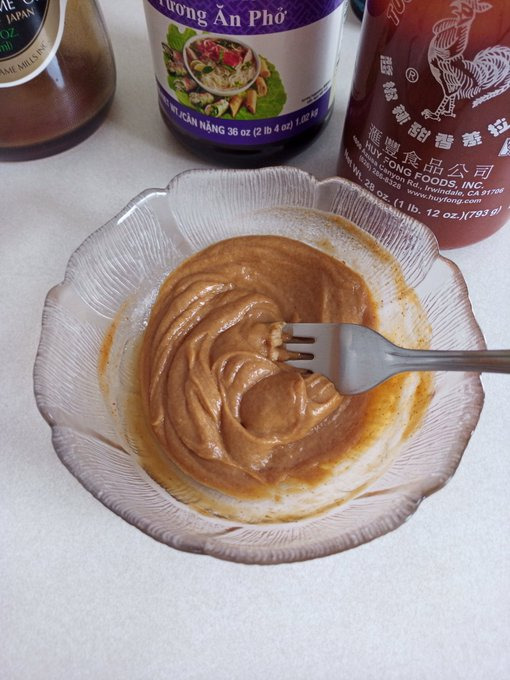
peanut sauce is just peanut butter+water, hoisin+sriracha sauce, and a tiny bit of sesame oil (tastes good with almost anything imo)
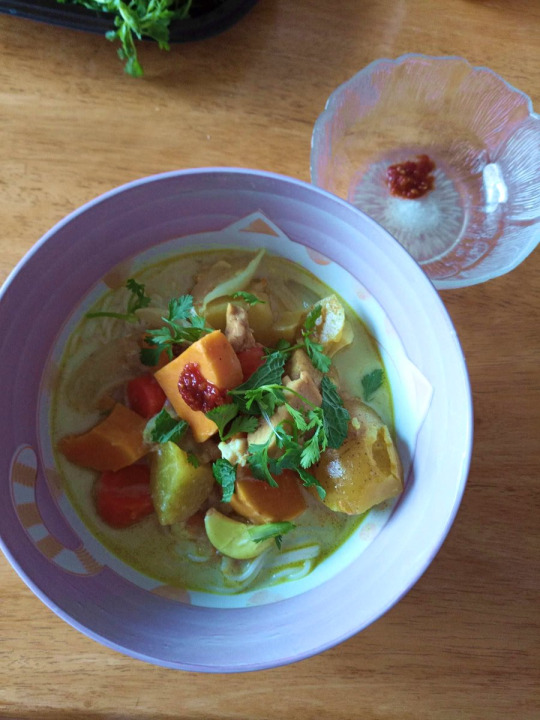
yellow curry
rice noodle with chicken, potatoes, yams, onions, carrots in a creamy coconut milk and yellow curry paste broth
lemon juice and salt mix with garlic chili for dipping

bò kho (vietnamese beef stew)
kho is a cooking technique where a protein is braised in a mixture of fish sauce, sugar, and water or coconut juice to make a salty/savory result
bread dips in stew beef/potatoes dip in lime juice/salt/pepper mix
cucumber slices to offset the salty
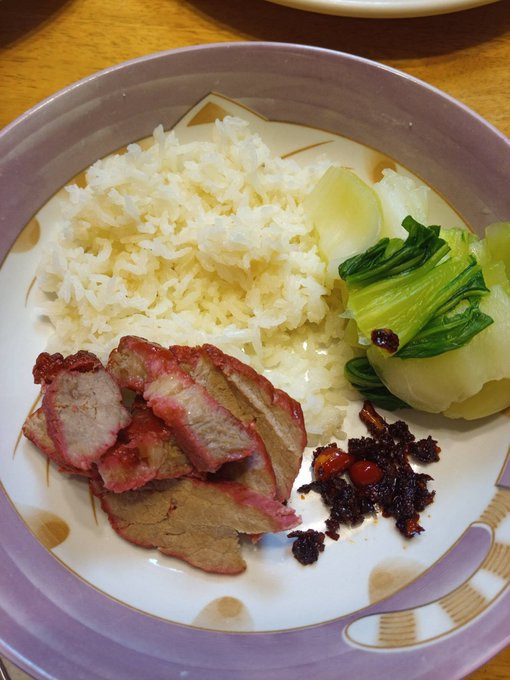
xá xíu (cantonese style bbq pork)
the seasoning mix is made of sugar, powdered soy sauce, onion and garlic powder, and spices
the pink color very much freaked out middle schoolers at lunch

cơm tấm (broken rice, grilled pork, egg, pickled carrots/daikon with scallions/oil garnish and fish sauce)
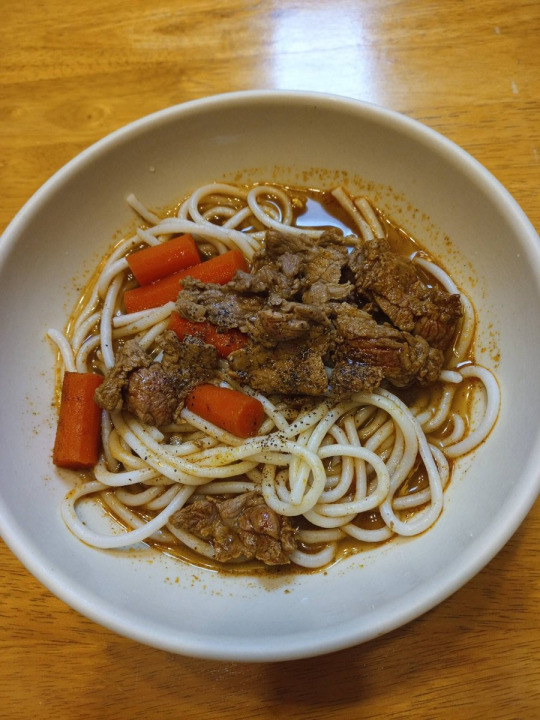
bún bò huế (thick round rice noodle with beef soup)
more "fun" than phở imo
bún bò broth: spicy salty flavor (lemongrass, spicy chili, fermented shrimp paste, fish sauce)
phở broth: earthy sweet flavor (cinnamon, star anise, onion, ginger, garlic, herbs)
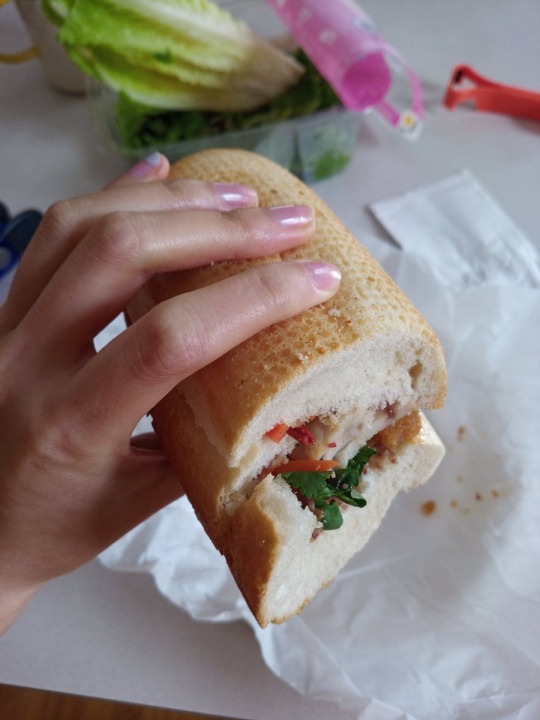
bánh mì (baguette sandwich with chả lụa (pork sausage), xá xíu (cantonese style bbq pork) coriander leaf (cilantro), cucumber, pickled carrots, and pickled daikon combined with pâté and buttery mayonnaise)

salmon instead of nem nướng̣ (viet grilled pork) with bánh hỏi (rice vermicelli)
feat nori (dried edible seaweed)
wrapped with lettuce and dipped in nước mắm (fish sauce)
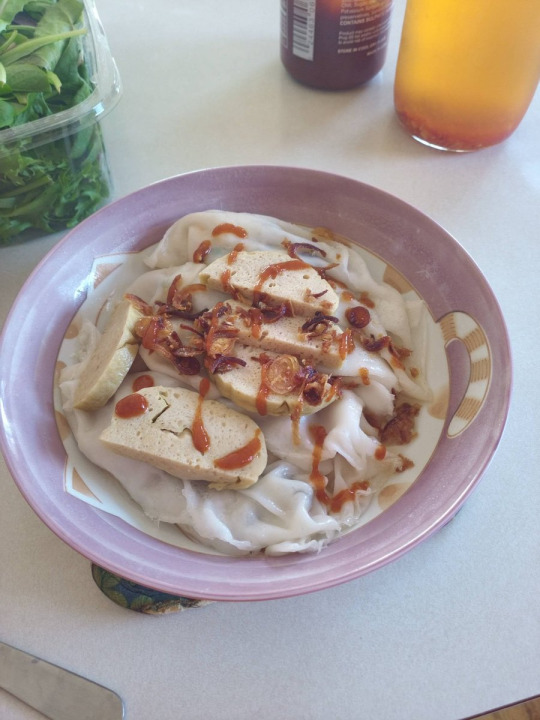
bánh cuốn (rice noodle rolls filled with ground meat, wood ear mushrooms, onions)
topped with chả lụa (pork sausage) and fried red onions and nước mắm (fermented salted fish sauce)
a fav of grandpa's
pizza man mispronounces it as "bun goo" which makes my mom giggle cause the way he says goo sounds like penis

bánh tét (glutinous rice rolled in a banana leaf into a thick, log-like cylindrical shape, with a mung bean and pork filling)
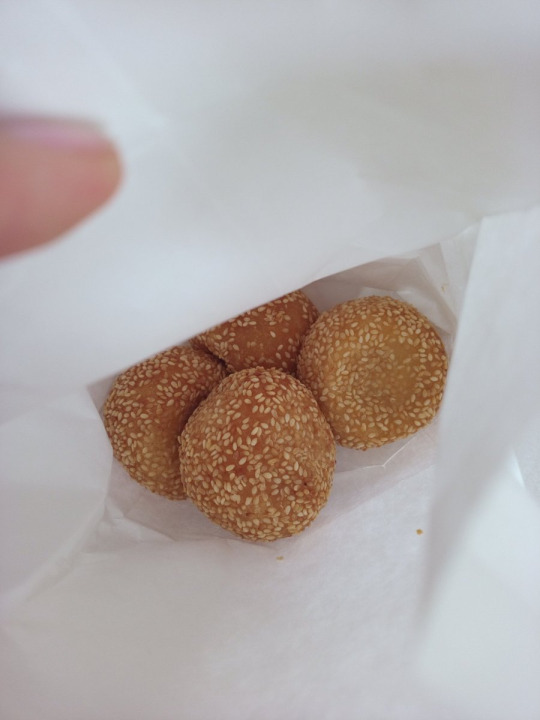
bánh rán (deep fried sesame ball filled with mung bean)
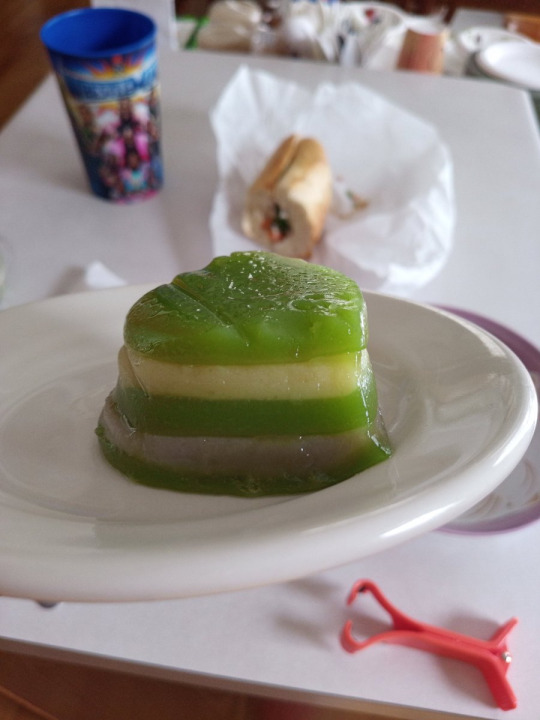
bánh da lợn "pig skin cake" (tapioca starch, rice flour, mung bean, taro, coconut milk)
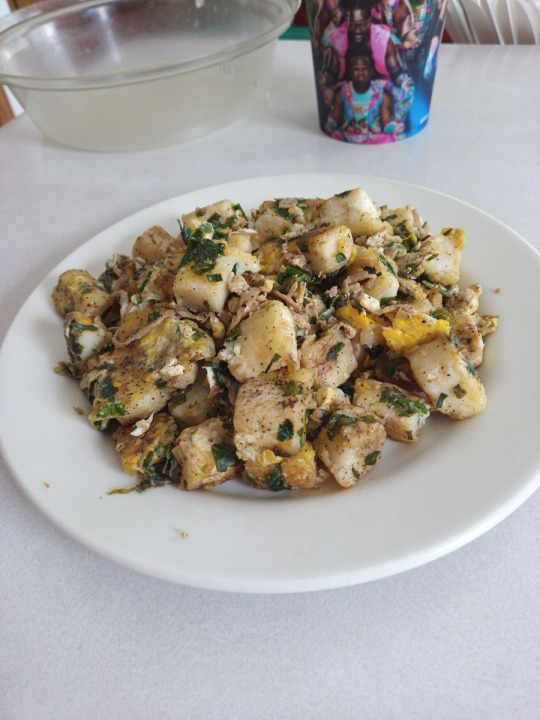
bánh bột chiên (fried taro rice cake, a fav of pizza man)

phở (broth: earthy sweet flavor- cinnamon, star anise, onion, ginger, garlic, herbs)
ive called phở mid but while eating this i was like huh this is good actually then my dad says this time he simmered chicken bones for hours like he's supposed to instead of using canned broth
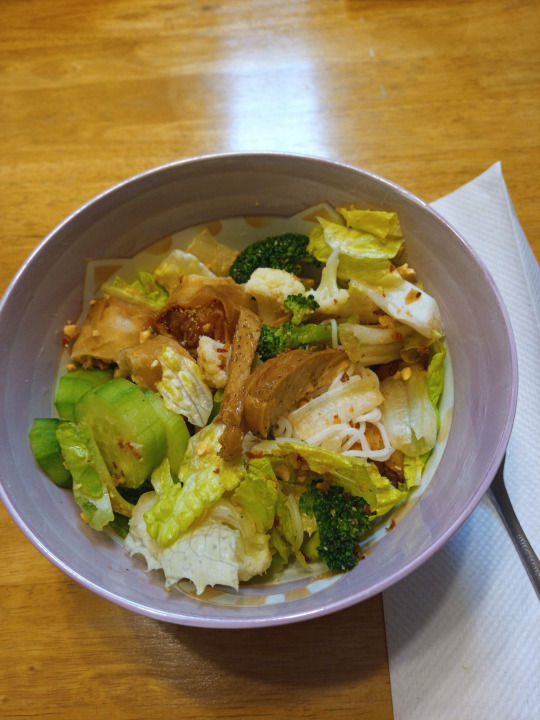
improvised bún thịt nướng (rice noodle bowl with chopped grilled pork, egg roll, veggies, crushed peanuts, fish sauce)
a way to deal with leftover noodles from gỏi cuốn
every time i eat this i think of the time me and pizza man were in new orleans and he asked if i wanted to eat at a viet place and i was surprised cause he's not really into a lot of viet food but anyway i got bún thịt nướng

thịt kho (pork with eggs braised in sticky savory caramel of sugar, fish sauce, coconut water)
i have distinct flashbacks of being in the middle school cafeteria with my thịt kho and kids around me going "what is that??", "ewwww" lol
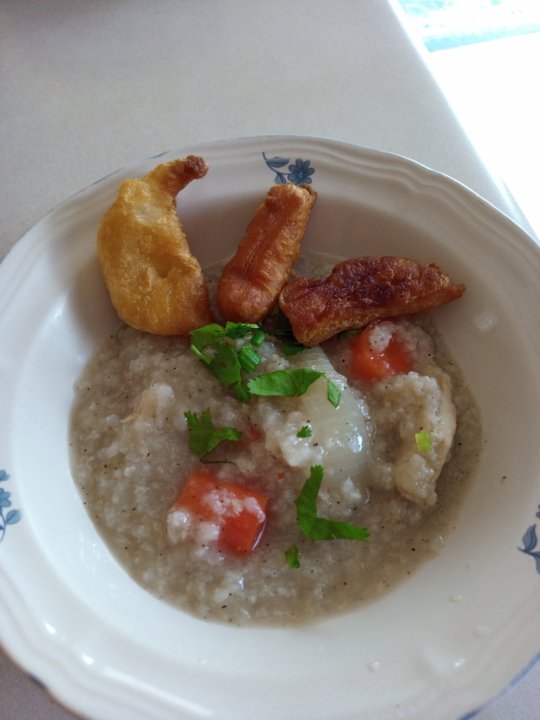
cháo (rice porridge with chicken or a white meat fish- often served with crunchy cabbage salad)
my dad likes it with youtiao (chinese donuts)
being sick means eating this! but we also eat it a lot when we’re not sick!
when my mom was young she would say yes to any dude that asked her out and order an obscene amount of food/the most expensive things on the menu and never hear from them again but my dad took her to a cháo place cause that was his favorite but apparently for cheapskates
he proposed two weeks later and she said yes
my mom is such a menace i wanna be just like her
70 notes
·
View notes
Text
Steps you can take now to start taming inflammation:
1. Prioritize anti-inflammatory foods:
•Heathy fats (omega-3s) - Olive oil, avocado, coconut, nuts & seeds
•Fruits high in vitamin C - citrus fruits
•Antioxidants - berries, green tea
•Vegetables -leafy greens
•Lean protein & legumes
•Herbs & spices - turmeric (curcumin), ginger, garlic, cinnamon
•Fermented foods (probiotics)
2. Juice alkaline, antioxidant, & chlorophyll-rich vegetables & fruits. Especially those that are green (kale, spinach, broccoli, spirulina, chlorella, basil, cilantro…).
Chlorophyll is alkalizing, high in antioxidants, & detoxifying. All of which help improve oxygen delivery throughout the body by promoting red blood cell production. Oxygen is like water on the inflammation fire.
3. Anti-inflammatory therapies:
•Hyperbaric oxygen therapy
•Cryotherapy or cold plunges
•Red light therapy
If you’re local, you can visit my friends @upgradelabsriverton and try these therapies.
#antiinflammatory #antioxidants #health #healthylifestyle #healthyfats #nutrition #wellness #guthealth #healthyfood #antioxidant #cbd #organic #antiinflammatorydiet #inflammation #detox #turmeric #chlorophyll #longevity #healthy #healthyliving #holistichealth #painrelief #natural #immunesupport #antiinflammatoryfood #immunesystem #omega #juice #juicing #foodismedicine
#antiinflammatory#Inflammation#diet#Nutrition#food#health#Healthy#healthy foods#healthyeating#chlorophyll#juicing#oxygen#HBOT#cellhealth#disease#disease prevention#autoimmune#autoimmune disease
4 notes
·
View notes
Text
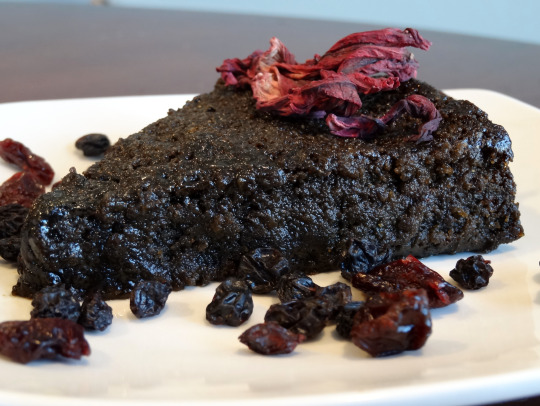
[ID: A slice of dark brown cake garnished with dried sorrel on a plate dotted with dried raisins and currants. End ID]
Jamaican black cake (optionally halal)
Black cake is a kind of fruit cake flavored with rum and spices and colored with burnt sugar. Variations on the cake are eaten throughout the Caribbean, primarily during Christmas but also for Easter or other celebrations such as weddings or birthdays. Dried fruits soaked in rum and wine, molasses, lime juice, warm spices, and sometimes rosewater produce the signature deeply fruity taste of Jamaican versions of the cake. Black cake often has a dense, smooth, pudding-like texture; I’ve made my halal version reduced gluten, to mimic the gluten-inhibiting effects of alcohol and produce that melt-in-your-mouth effect.
This recipe was requested by a patron; you can request recipes or vote on what I upload next by joining my Patreon.
Recipe under the cut!
Makes one 8" cake.
Ingredients:
For the cake:
1 cup (120g) all-purpose flour (substitute almond meal for a gluten-free version)
1/2 cup (55g) almond meal (substitute all-purpose flour if using rum)
1/2 cup non-dairy margarine, softened
1 cup unrefined sugar (such as muscavado or sucanat), or organic light brown sugar
3 Tbsp Jamaican or Caribbean molasses (if using brown sugar instead of unrefined)
3 Tbsp neutral oil, such as canola
2 Tbsp water or rosewater
1 tsp ground cinnamon, or 2-inch piece cinnamon stick
1/2 tsp ground nutmeg, or 1 tsp freshly grated
1/2 tsp ground allspice (preferably Jamaican), or 16 allspice berries
1/2 tsp ground cloves, or 16 whole cloves
1/2 tsp ground mace, or 1 head
5 Tbsp Caribbean browning (store-bought may be too bitter; taste and maybe use less)
Juice of 1 lime (about 2 Tbsp)
Zest of 1 lime
1 Tbsp baking powder
1/2 tsp table salt
2 cups (460g) soaked fruit mixture
1 tsp vanilla extract
1 tsp almond extract
My freshly ground spices totalled 9 grams; because freshly ground spices incorporate more air, you may want to include a bit more than I used by volume to account for settling.
Organic brown sugar is evaporated from cane juice and retains some of its original molasses, but less than unrefined sugars do. Non-organic brown sugars may be refined sugars with molasses added back in. Organic brown sugar is sure to be vegetarian (not filtered with bone char)—other refined sugars may or may not be suitable for vegetarians.
Unrefined sugars such as muscovado retain more of their original cane molasses, but they may clump and need to be grated before they can be used in baking. Sucanat is an unrefined sugar that should be pourable.
For the soaked fruit:
1 1/3 cup (130g) mixed black raisins, dried prunes, dried currants, and dried cherries
About 1/2 cup white rum (Wray and Newphew overproof rum is popular in Jamaica)
About 1/2 cup sweet red wine (commonly, Wray and Nephew red label)
Black raisins, prunes, currants, and dried cherries are the most typical fruits to use in black fruit cake. Many Jamaicans today also include mixed peel and red or green glacé cherries. Most recipes include more prunes and raisins than other fruits, but prunes make the cake too bitter for some people's taste; consult your own preference.
Most recipes call for “white rum,” but there is no clear dividing line in terms of flavor between “white” and “dark” rum. Some light rums are the result of ageing and subsequent filtering, while some dark rums have been aged less but have had color or molasses added in. If in doubt, just use something you like!
For the halal rum and wine mixture:
My halal 'rum' uses fruits, herbs, and spices that mimic the funky, fruity, vegetal notes of a Jamaican rum; it also takes inspiration from other drinks common in Jamaica. Ripe fruit is a source of the esthers that give rum its signature fermented taste, while sorrel and malta help to produce a well-rounded flavor. The point is not necessarily to taste ‘like’ rum, but to replace its complexity in the cake.
1 cup water or coconut water
1/2 black overripe banana or plantain, with its peel
Other ripe fruit, such as a handful of raspberries or a few slices of mango (optional)
1 Tbsp (2g) dried sorrel (hibiscus; optional)
1/2 inch chunk (5g) ginger
2-inch piece (2g) Ceylon cinnamon
2-inch piece (2g) cassia cinnamon (I used a mix of Chinese and Indonesian)
4 whole cloves
6 allspice berries
1/4 tsp grated nutmeg
A few pieces (1g) dried orange peel, or zest of one orange
2 ciliment (bay rum) leaves
1 Indian bay leaf (tej patta)
2 Tbsp West Indian molasses, or malta (Jamaican soft drink)
1/2 tsp vanilla extract
1/2 tsp almond extract
1/2 cup red grape juice (in place of the wine)
Any ingredients you don't have (except for the grape juice) may be omitted.
Instructions:
For the halal rum and wine mixture:
1. Roughly crush ginger and spices in a mortar and pestle or with the flat of a knife. Simmer fruit, sorrel, spices, bay leaves, and orange peel, covered, in water or coconut water for 10 minutes. Remove from heat and allow to steep for about an hour, still covered.
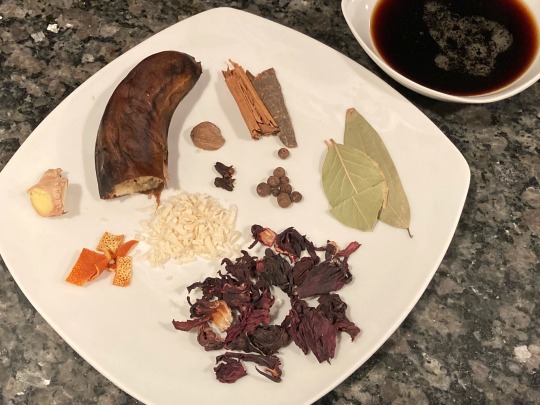
2. Strain mixture through a nut milk bag or coffee filter to remove fruit pulp. Mix in extracts, molasses or malta, and grape juice.
3. Top up mixture with more water if necessary to achieve a total volume of 1 1/3 cup (315mL).
For the soaked fruit:
1. Combine all fruits (including mixed peel and glacé cherries, if using) with enough rum and wine mixture to cover in a large glass jar. If using the halal rum and wine mixture, you should have at least 1/4 cup of it left over.
2. Soak dried fruits for a minimum of a week and up to a year (if using rum). Some bakers begin soaking fruit for the next year's cake immediately after Christmas! Keep fruits at room temperature while soaking if you're using rum, or in the fridge if not using alcohol. Occasionally check back and top up the liquid if the fruits soak some of it up and are no longer covered.
You may also choose to simmer the fruits for a few minutes and then soak them for a few hours if you're in a hurry.
3. Optionally, grind soaked fruits in a blender or food processor until smooth and paste-like. Whether you keep the fruits whole or grind them depends on what texture you want in your cake; I ground them to create a smooth, dense texture.
For the cake:
1. Whisk together all dry ingredients except for sugar (flour, almond meal, lime zest, spices, baking powder, salt) in a large mixing bowl.
2. Beat 1/2 cup softened margarine in a medium bowl with an electric beater until smooth. Add 1 cup sugar and beat for several more minutes until creamy to incorporate air.
3. Place 2 Tbsp water or rosewater in a small bowl and slowly add 3 Tbsp oil while whisking to create an emulsion. Slowly add the mixture to the creamed margarine, continuing to beat.
4. Slowly add 2 Tbsp lime juice and vanilla and almond extracts (1 tsp each) while mixing with a wooden spoon or rubber spatula. Add 2 cups (about 460g) fruit paste, 5 Tbsp browning, and 3 Tbsp molasses (if using brown rather than unrefined sugar) and mix.
5. Add flour mixture a little at a time and fold until well combined, with no remaining dry spots.
6. Bake in a parchment-paper-lined 8" cake pan at 250 °F (120 °C) for about 2 1/2 hours, until a toothpick inserted into the center of the cake comes out clean. The low temperature and long cooking time help to give the cake its smooth, dense texture.
7. As soon as you remove the cake from the oven, pour about 1/4 cup of your rum and wine mixture over the cake—this makes the cake very moist, as well as ensuring that the more volatile aromatics in the rum don’t disappear during baking.
8. Spray the cake with the wine and rum mixture every few days. It will be at its best a few days after baking!
The cake may be stored in an airtight container at room temperature for about 5 days (then moved to the fridge and stored for another week) if containing rum; a halal version will need to be stored in the fridge from the beginning.
113 notes
·
View notes